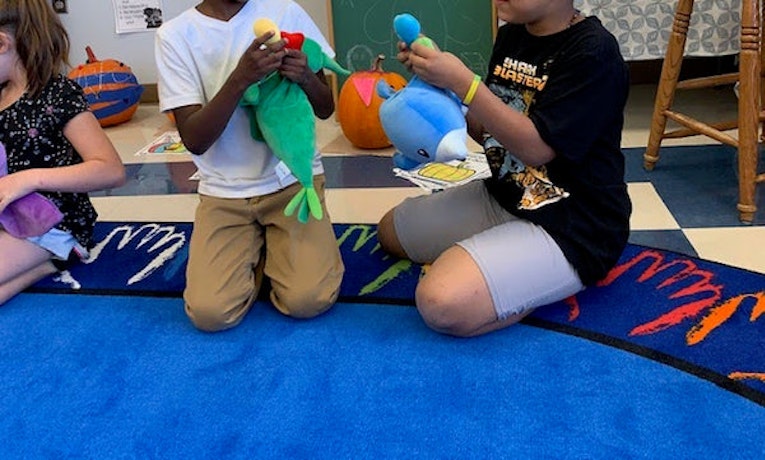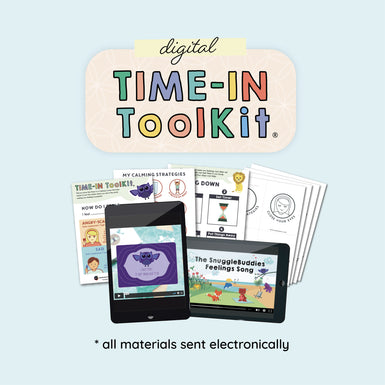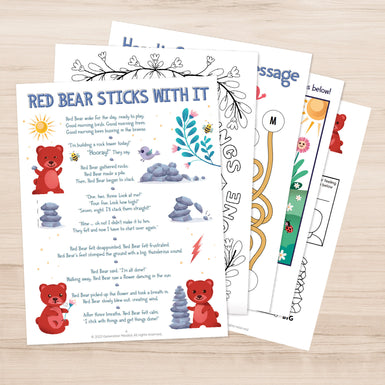When I walked into her classroom, I could tell something was different. It was 8:15 AM and all of her students were sitting on the floor in a circle. There was a palpable calmness that swept over me as I walked to the back of the room. The students sat comfortably and appeared focused on one person.
As the school counselor, the teacher had requested I come in and observe her new morning meeting format. I found a chair in the back of the room and curiously looked at the student that the others were staring at.
I noticed right away that this student was holding a SnuggleBuddies, Violet the Elephant, a tool our district was using to nurture children's social-emotional skills in our classrooms. The student held up the blue tear-drop shaped charm that was hanging from Violet and said, “Today, I’m feeling tired.”
The teacher responded, “Is there anything you would like the class to know that would be helpful for you today?”
The student said, “Yes, please be patient with me if I get grumpy, I get grumpy when I am tired, but it’s not about you.”
I was taken aback. This second-grader had just identified her feelings,AND calmly expressed her needs. The rest of the class responded, “Thank you for sharing. We will do our best”. The student then handed Violet Elephant to the next student.
What did I just witness? Maybe this student was emotionally mature? I watched for the next fifteen minutes until every student responded. I continued to be amazed at the simple, yet deep, level of emotional awareness that these students were expressing.
After the activity, they all stood up and walked back to their seats to begin their day. It was 8:30 AM and these students already understood how to support each other on a deep and empathetic level.

I had introduced the Generation Mindful SnuggleBuddies to my staff three months before I came into this classroom. Our school has a diverse population and is around 78% economically disadvantaged. Many of the teachers immediately saw the benefit and used Generation Mindful (GENM) materials and some had begun to use them in their classrooms in their own unique ways.
As a school counselor, I was using SnuggleBuddies to work with students individually and in groups, but not yet in a whole group. The level of connection I witnessed when visiting a second-grade classroom inspired me to start my counseling classes with a SnuggleBuddies routine.
After this classroom of second-graders had started their independent work, I asked the teacher how she had supported her students to engage in this level of connection and sharing. “There is no big secret there,” she began, “we just practice sharing how we are feeling using the SnuggleBuddies at the start of every day.”
She went on to explain that, in the beginning, many students preferred not to share and that she, of course, never forced them to, but once they did feel safe sharing, she would invite each student to also share what, if anything, they might want in the way of support from their fellow students. She did this initially by sharing her own experience with that feeling, and over the course of six weeks, with daily morning meetings, her students began to feel comfortable identifying their feelings and asking for what they felt they needed.
As a longtime school counselor, I was inspired by what I was seeing and hearing for many reasons. Here are three tips for teaching kids about emotions that I saw put into practice that day, and I hope they inspire you as well.
The Power of Rituals
Creating a consistent routine helps students feel safe and secure. When a predictable routine is established - such as sharing feelings with the SnuggleBuddies - levels of stress, anxiety, and insecurities can be minimized, establishing a positive tone and setting students up for success throughout their school day.
The Power of Play
If you think back to lessons you learned early in your education, it's likely that the most memorable ones have an element of play. Why? Because play is an early childhood educator's most powerful resource, enhancing focus, memory, depth of knowledge, connection, and engagement.
The Power of Student-Led Activities
Students have been shown to respond positively to the opportunity to take ownership of their learning experiences. Research shows that child-led learning of this nature positively affects the learner's maturity, development, creativity, and intrinsic motivation.
Before leaving the classroom that morning, I took the opportunity to ask this teacher one more question: “Why do you think that incorporating SnuggleBuddies into your morning meetings has made such a big difference for the students in your classroom?” She responded that SnuggleBuddies give her students both a comfort item to hold and a visual reminder of the four main mood groups --- both of which she believes help them feel more confident sharing their feelings. She also felt that their new ritual was setting a positive tone for "cohesiveness and restoration".
"The seeds of cohesiveness and restoration", I thought to myself, this is what I had just witnessed. And this is why, when later that same day the student who shared she was feeling tired inevitably got grumpy with another student, the class was able to give that tired student the patience she'd asked for earlier that very same day.
_____________
Generation Mindful creates tools, toys, and programs that nurture emotional intelligence through play and positive discipline. Join us and receive joy in your inbox each week.


























